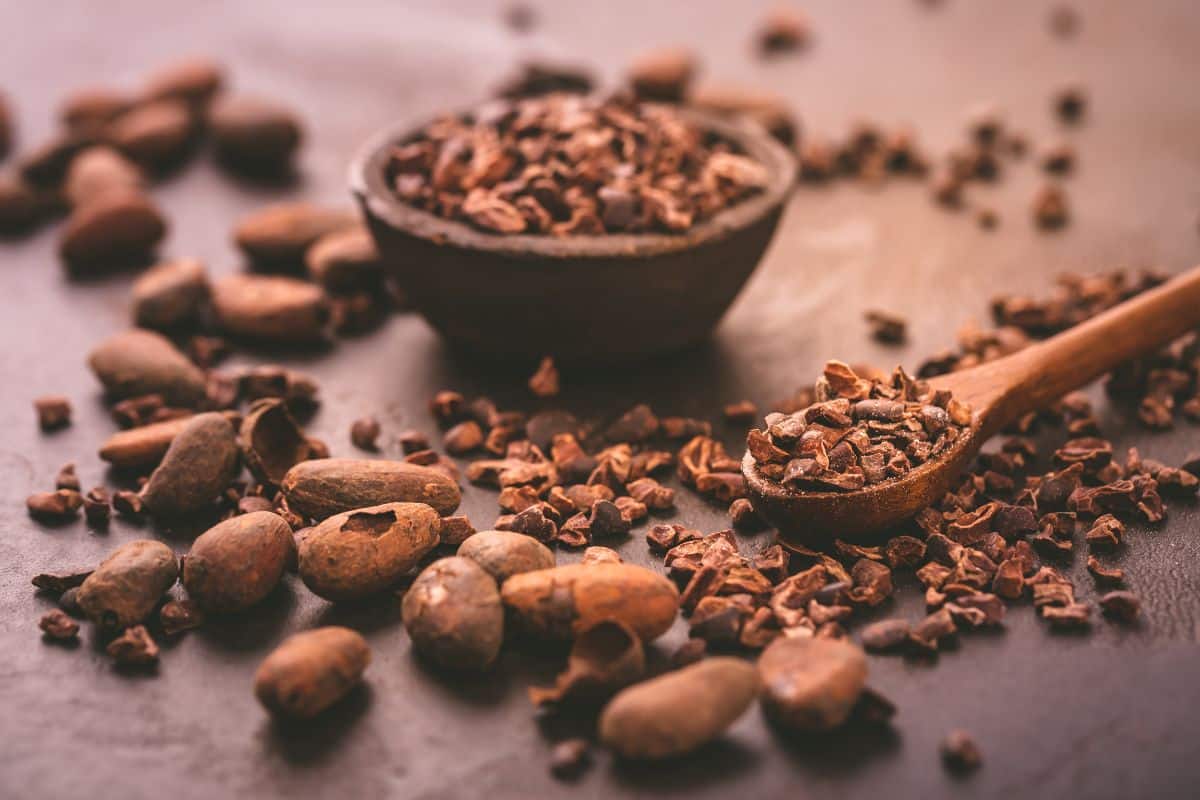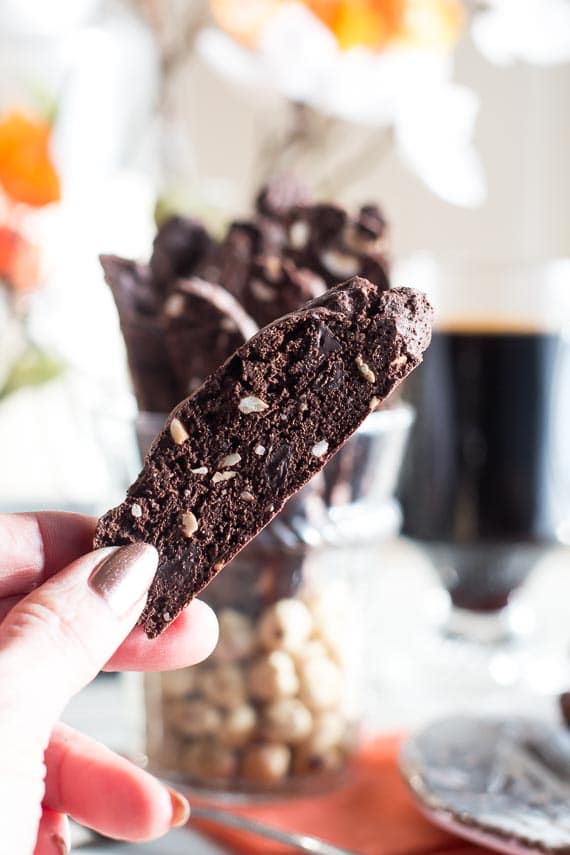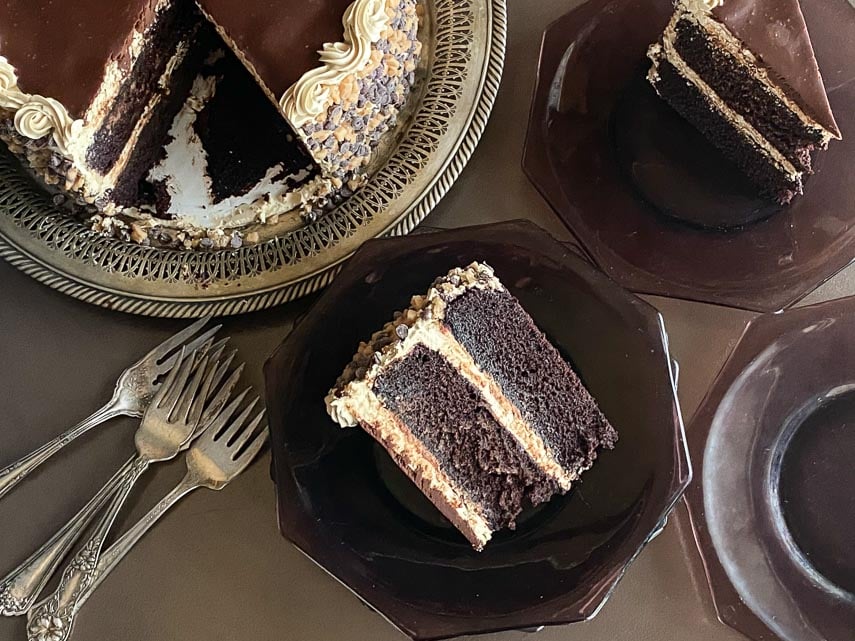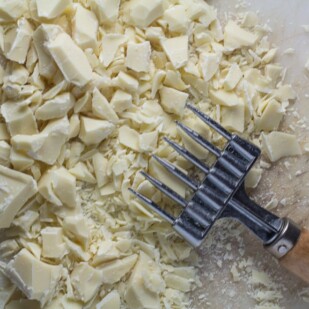The purpose of this article is to teach you All About Dark Chocolate in relation to the low FODMAP Diet.

- Dark Chocolate Defined
- Is Dark Chocolate Low FODMAP?
- Monash University Lab Tested Low FODMAP Dark Chocolate Amounts
- FODMAP Friendly Lab Tested Low FODMAP Dark Chocolate Amounts
- Dairy In Dark Chocolate
- What Does All This Mean? How Much Chocolate Can I Eat?
- Unsweetened Chocolate, Cacao Mass, Percentages & Cacao Nibs
- Frequently Asked Questions
- Low FODMAP Recipes Featuring Dark Chocolate
Dark Chocolate Defined
The term “dark chocolate” typically encompasses bittersweet and semisweet chocolate, and from a U.S. perspective, this makes sense, because the FDA does not distinguish between those terms. As long as the chocolate contains 35% cacao mass, it can be labeled either semisweet or bittersweet chocolate – and it CAN contain dairy (more on dairy inclusion later).
Understanding Chocolate Label Language
When you see a percentage on a chocolate label, such as 50% chocolate, or 50% cacao, or 50% cacao mass, these all mean the same thing. They are referring to the amount of cacao bean used in the manufacturing process of that chocolate.
Unsweetened chocolate is 100% cacao mass. A bar with 50% cacao will also have sugar, possibly extra cocoa butter, dairy, vanilla, lecithin, or additional ingredients, but the the “%” is the actual “chocolate” in the bar.

For this article, All About Dark Chocolate & The Low FODMAP Diet, we cover all kinds of dark chocolate, including unsweetened chocolate and cacao nibs. For information on cocoa, please refer to All About Cocoa. There is a lot to learn there, as well.
YES, dark chocolate is low FODMAP and you CAN have dark chocolate on the low FODMAP diet.
Is Dark Chocolate Low FODMAP?
As with so many ingredients, it comes down to serving size, but the short answer is YES, dark chocolate is low FODMAP and you CAN have dark chocolate on the low FODMAP diet.
Monash University has lab tested two kinds of dark chocolate and each has its own recommended amounts. For this article I have used the terms that Monash uses, so you can match the info here with their smartphone app.

Monash University Lab Tested Low FODMAP Dark Chocolate Amounts
Before we dive into the details, we have to mention how the Monash University smartphone app works. You can read more in our article, How To Use the Monash University Smartphone App, and also the article titled Monash University Low FODMAP Lab Testing Explained.
What we want to bring to your attention is that all the lab testing that they conduct is trustworthy. Unfortunately, the app can only show us current lab testing information, and sometimes older information is valuable and removed. Such is the case for dark chocolate.
Luckily we have that information archived in this article and this additional information is important to understanding how to assess dark chocolate from a low FODMAP perspective.
Monash University Dark Chocolate Serving Sizes
- 85% Dark Chocolate: The 85% refers to the percentage of cacao mass. Green Light/Low FODMAP is 20 g; does not become Moderate for FODMAP until ≥350 g. (Monash has inexplicably removed the Moderate info during app updates).
- Dark Chocolate: No cacao percentage given. Green Light/Low FODMAP is 30 g; Moderate at 80 g (lactose being limiting factor); HIGH at 125 g (lactose and fructans present).
Why are the amounts different? It is actually not initially clear, but we can glean answers in the details.
Additional Dark Chocolate Information re: Monash Lab Testing
What many people do not realize is that many of the serving sizes in the Monash University app and FODMAP Friendly app are determined by Australian government healthy eating guidelines and have nothing to do with FODMAPs.
And it is important to note that the serving sizes for these dark chocolates are based on the inclusion of dairy (see below). We know this because the primary FODMAP listed is lactose.
The Red Light/High FODMAP amount is determined to be 125 g or about 4 ⅓ ounces, at which point fructans are also present. This does not make sense and has not been explained by Monash, and is particularly curious given the other 85% dark chocolate app entry (see below).
The information in the section below is partially derived from lab testing that is no longer publicly available elsewhere.
For 85% Dark Chocolate, the small print that existed previously showed us that it does not become Moderate until ≤350 g. That is a huge portion – and there is no mention of fructans at that amount or higher, but instead, there is of GOS (again, this info has since been removed from the app, but the lab tests were done and were accurate for the chocolates tested).
Retain this information, because it showed us that with higher cacao percentage chocolates, that one can enjoy very large portions, while remaining low FODMAP suitable for the Elimination Phase.

What to Ignore
You will also notice that Monash says that, “5 squares or ½ small bar” of Dark Chocolate is low FODMAP. This means nothing. It’s like saying ⅛ of an avocado is low FODMAP, when an avocado can weigh 3-ounces or over 5-pounds! Always pay attention to the weights.
FODMAP Friendly Lab Tested Low FODMAP Dark Chocolate Amounts
FODMAP Friendly also has an entry for “dark chocolate” on its app, and we can see that the chocolate that they lab tested contains lactose as well. They also use the maddening “5 pieces” language.
FODMAP Friendly Dark Chocolate Serving Sizes
According to FODMAP Friendly, “dark chocolate” (we do not know cacao mass content) has a suggested serving size of 30 g, with a max serve of 102 g. Their details show us the limiting factors are both fructans and lactose.
Dairy In Dark Chocolate
Monash University and FODMAP Friendly both lab tested dark chocolates that contain dairy. Most better quality dark chocolates do not contain dairy. High quality dark chocolate should contain cacao mass, sugar and perhaps vanilla and lecithin (an emulsifier) – and nothing else. (By the way, soy lecithin is low FODMAP).
(We are talking about pure dark chocolates of course. If you are looking at a bar that has nuts or caramel or another inclusion or flavor, then that is a flavored bar. Another exclusion would be dark milk chocolates. Milk chocolates are chocolates that contain dairy but have cacao content of 40%, 60%, 70% and more; please see our milk chocolate article).

Some companies do add a dairy product, or multiple dairy products, to their dark chocolates. The American classic Nestlés Toll House Morsels contains dairy, as does the 60% Ghirardelli bar, which I do often recommend as a decent U.S. supermarket chocolate with that cacao percentage.
The dairy will add richness and you can detect a different kind of mouthfeel in these chocolates. The dairy coats my palate, but not in a good way (my opinion). It is a cheaper way to create a richness in a chocolate without more (or any) expensive cocoa butter.
Our recommendation is to use the Monash and FODMAP Friendly lab tested serving size amounts of dark chocolate as a guide, paying attention to the small print, which has information on larger servings, and to always listen to your body and eat to your tolerances.
What Does All This Mean? How Much Chocolate Can I Eat?
All of this information tells us many things:
- Monash and FODMAP Friendly lab tested dark chocolates that contain lactose (dairy products), and that became a significant limiting factor in determining low FODMAP serving size. You CAN buy dark chocolate without dairy.
- Low FODMAP serving sizes will be higher for dark chocolate without dairy.
- 85% cacao mass chocolate is low FODMAP up to 350 g, per the lab testing done by Monash University.
- Fructans show up at 125 g, in the Monash lab test of Dark Chocolate. This does not make sense, and has not been explained by Monash, since the 85% chocolate does not become Moderate until ≤ 350 g, and no fructans are shown, although GOS were.
- When inexplicable results occur, Monash always defers to what the lab tests show, even though they do not seem to make sense. We suggest you just accept them as well.
- It might be helpful to review our article, When Monash University and FODMAP Friendly Low FODMAP Lab Test Results Differ.
- Most importantly, it means you CAN have Dark Chocolate while following the low FODMAP diet.
- Our recommendation is to use the Monash and FODMAP Friendly lab tested serving size amounts of dark chocolate as a guide, paying attention to the small print, which has information on larger servings, and to always listen to your body and eat to your tolerances.
Unsweetened Chocolate, Cacao Mass, Percentages & Cacao Nibs
In its most simple form, unsweetened chocolate (also called chocolate liquor, even though there is no alcohol involved) will contain one ingredient – cacao mass. Cacao mass is made up of crushed cacao nibs, which are the very center of the cacao bean. They are very high in fat – which happens to be cocoa butter.
So, a bar of unsweetened chocolate should say 100% chocolate – or 100% cacao, 100% cacao mass, 100% cocoa or 100% cocoa mass or something similar, and it will only contain the cacao nibs, all ground up, which also contain a fair amount of fat (cocoa butter).

Unsweetened chocolate has not been tested as of this writing, BUT, cacao nibs have been tested and unsweetened chocolate is ONLY made from cacao nibs. Also, cocoa has been lab tested as well, and cocoa is made from pure cacao nibs with some fat removed. Please read our article on cocoa.
FODMAP Friendly has an app entry on cacao nibs: low FODMAP at 1 teaspoon (4 g), with a max low FODMAP serving of 28 g.
Even though cacao nibs are not in the Monash app as a line item, they have made their way into foods that Monash has lab tested and certified as low FODMAP such as goodMix Blend 11. This means that some amount of cacao nibs are low FODMAP, per Monash, as well.
You might also be interested in our articles: All About Milk Chocolate and All About White Chocolate.
Frequently Asked Questions
Yes, dark chocolate can be low FODMAP.
No one can tell you what will trigger your IBS. Some people react negatively and it might be from the fat and caffeine inherent in chocolate. Both fat and caffeine can be IBS triggers.
The label should only contain cacao mass, sugar, cocoa butter, and perhaps vanilla and/or lecithin. That will be a very high quality chocolate. However, it also depends on the intended use.
If you are buying a chocolate to savor, bite by bite, I would suggest chocolates different from chocolates to cook and bake with. For the latter, always go by what the recipe asks for. The recipe should give you specifics, like cacao mass content. If it does not, I would not trust the recipe.
It is going to depend on where you live. In the U.S. look for Lindt and Ghirardelli for bars. Some markets also have Guittard; all are decent for baking.
I am partial to Guittard, Ghirardelli and Scharffen Berger.
For chips (also called morsels), you can use Ghirardelli, Guittard or Nestlé.
Lecithin is low FODMAP and not an issue.
Cocoa butter is a fat and contains no FODMAPs, which are carbohydrates.
Always follow directions in individual recipes (some brownies just use cocoa). If you have to melt dark chocolate for a brownie recipes – or for ANY recipe that calls for melted chocolate – do NOT try to melt chips. Chips are formulated to hold their shape and do not melt well. Think about it…you put those chocolate chip cookies in a 375°F (190°C) oven for 10 to 15 minutes and those chips don’t melt…chop up a bar.
If a recipe calls for a 55% cacao mass chocolate, do not substitute a 70% cacao mass chocolate. Recipes should tell you what kind of chocolate to use; please use what is mentioned in the ingredient section, or you risk having the recipe fail.
Low FODMAP Recipes Featuring Dark Chocolate
Low FODMAP chocolate lovers rejoice! Which low FODMAP dark chocolate recipe will you make first? These are just a few that we have in store for you:
- Low FODMAP Mocha Toffee Crunch Cake
- Low FODMAP Chocolate Creme Brulée
- The BEST Low FODMAP Hot Chocolate (not hot cocoa, although we have that recipe, too)
- Low FODMAP Chocolate Cheesecake

- Low FODMAP Chocolate Hazelnut Biscotti
- Low FODMAP Chocolate Caramel Tart
- Low FODMAP Chocolate Truffles












Please let me know about white chocolate and how to begin to re introduce food, which food first, could be some fruit? Or garlic? Onions? Thanks
Hi Myriam, We have an article on white chocolate. The diet is nuanced and is best undertaken along with a FODMAP trained registered dietitian. As far as re-introductions and the Challenge phase in particular, Joanna Baker from Everyday Nutrition has a fabulous program.
Of what I see, Monash app includes cacao powder, where yellow light starts with 200g (fructans and GOS) and cocoa powder (yellow light starts with 20g!).
If I understand well, cacao butter is nearly pure fat so it doesn’t bother us about FODMAP content. So if I make my own chocolate using cacao butter, cocoa/cacao powder and some kind of sweetener low in FODMAP, the amount of cocoa powder used will limit the amount of green light quantity of chocolate.
To sum it up: the less cocoa/cacao powder , the more chocolate one can eat. Is it right?
I like your thinking! From what we know, cocoa butter, as a fat, would contain no FODMAPs. Then, we have a problem. Timing is funny. I actually was giving a chocolate class last night, where I do a tasting and also talk about cacao production, manufacturing and touch upon cocoa powder and cacao butter as well. Here is the issue: technically cacao powder and cocoa powder are the same thing. So a reach-out to Monash is in order before we can proceed with the discussion. I would want to know what exactly what they tested and how they are differentiating. I would suggest that you reach out to them on their FACEBOOK group and I will send an email as well. Then we can reconvene!
This can get confusing! Can you give me a name brand of a chocolate bar that is low fodmap?
Hi Linda, Since I do not know where you live, whether you want chocolate for baking or eating, or are looking for white, milk or dark, this is a hard question to answer. Hopefully you have found the complementary artices for milk and white chocolate. All the answers are in this article here for basics. Look for a label that looks like this: cacao, sugar, cocoa butter and maybe vanilla and lecithin, for good quality chocolates. Sugar listed first will be a sweeter chocolate. If baking, use the cacao percentages listed. If a brownie recipe calls for 55% cacao mass chocolate, do not buy and use a chocolate that says 70% or does not say at all. For eating I go high end, because I appreciate great chocolate and don’t want to waste calories on poorly made chocolate.
I can’t believe the findings on dark chocolate…Lindt 85%, 78% And 70% all cause me digestive grief!
Hi Joyce, the lab findings are correct. Just because something is proven low FODMAP does not guarantee that it will not agree with your digestion. So sorry you felt poorly.